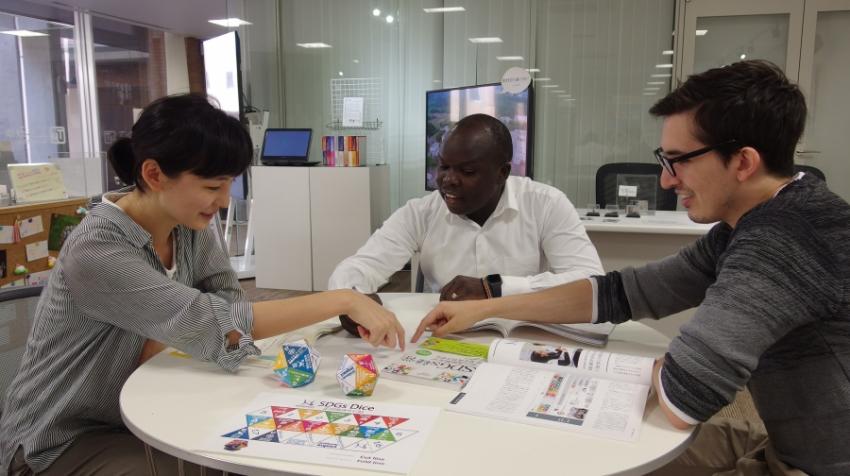One year ago United Nations Academic Impact announced the inauguration of the UNAI SDG Hubs, UNAI member institutions selected as exemplars for their innovative scholarship and engagement related to the Sustainable Development Goals (SDGs), who serve as resources for best practices for the UNAI network, currently composed of over 1,400 universities and colleges in more than 130 countries.
On the anniversary of the program launch, we’re taking this opportunity to check in with some of the hub schools to highlight their scholarship and activities over the past twelve months and look ahead to future initiatives. The third school profiled in our anniversary series is the Nagaoka University of Technology, hub for SDG 9: Industry, Innovation and Infrastructure. The university provided reflections by students from multiple countries, young engineers who describe how they see the future in 2045, at the 100th anniversary of the UN’s founding.
Hakko x Science x Local (by Yukina Kitahara, Japan)
Fermented foods have existed in Japan since the Jomon period (16,000-3,000 B.C.). In the era of no refrigerator fermentation, or Hakko as it is known in Japan, was used to preserve foods for a long period. Nowadays, fermentation cultures exist around the world. Still, the Japanese word Hakko is used instead of fermentation because it focuses not only on the process, but also on the culture of unique Japanese technologies and regional characteristics.
Refrigerators are the most power-consuming appliances in a home, accounting for over 10% of Japanese annual CO2 emissions. If we can reduce energy consumption by preserving more foods through fermentation, we can help advance several Sustainable Development Goals, including those related to sustainable cities and communities and responsible consumption (SDGs 11 and 12).
Hakko is integral to my research. In the next 25 years I would like to continue my research activities, and contribute to my country, starting from the local community. My hometown was prosperous in the Jomon period and is now known as Hakko and Brewage city. By scientifically studying Hakko, we intend to make the knowledge and technology gained from Japan’s fermentation industry to the world to be applied in local communities. Nagaoka University of Technology’s biotechnology engineering department is world class and provides its students with the skills to make a difference in Japan and beyond.
Gentle robots: A brighter future for both the young and the elderly (by Padron Parraga Juan Vicente, Venezuela)
Population aging is a phenomenon that is gaining momentum worldwide, and according to United Nations reports, by 2050 one in six people in the world will be over age 65. That means 16% of the population will need some kind of assistance in their daily lives, mostly physical.
My research focuses on the development of robotic actuators capable of precise force control in order to build robots that can safely and gently interact with humans. Good results have been achieved in the past ten years, but much more hard work and research are still required.
As an engineer, I dream of a future in which humans and robots can collaborate and interact together in many ways, and in particular, where the elderly, with the assistance of robotics, are capable of maintaining the same quality of life they had before. Exoskeletons suits, intelligent prostheses, nursing robots, collaborative robots, and such will improve the mobility and autonomy of older adults, while also easing the burden on the younger population.
My vision for the future is a society where the elderly can be as active as the young. Senior citizens will not see themselves as a burden. Instead they will take care of themselves with the assistance of robotics and keep contributing to their community. I aspire for a brighter future where both the young and the elderly sustain each other. To that end, robotics is the critical tool to help them live to their fullest potential.
A Young Engineer's Vision for 2045 (by Victor Vojoki Caesar Zemangi, South Sudan)
With the recent new developments and technological advancements in today’s world industries, we found that the motor drive system plays an increasingly significant role that is expected to continue for decades to come. The motor drive system has contributed to industries such as robotics, cars, railways, green energy, and modern agriculture and my research focuses on minimizing the electrical losses in the motor drive with two resonant inertia system. This system consists of a motor coupled to load with a flexible joint or coupling, and a good example is found in robots and the robotic industry.
As a young engineer from Africa, I know that the continent is experiencing rapid urbanization and profound change and the demand for motorizing systems will increase by 2045. All these expectations depend on today’s research and development and young engineers and technology to implement them. The Sustainable Development Goals will also play a crucial role. With growing urbanization in African countries, it’s most necessary to research for clean water, environmental changes, health, green energy, agriculture, and information. I see young engineers and researchers playing a more significant role in the next phase of the continent’s advancement.
In 2045, I see Africa free of aid, integrated with modern roads, information systems, modern agriculture, advanced power grids, and railways. An economically independent continent and younger generations, including engineers and researchers, are embracing new development and are turning Africa into a producing and manufacturing continent.
To learn more about the UNAI SDG Hubs, including Nagaoka University of Technology, visit the United Nations Academic Impact SDG Hubs.

